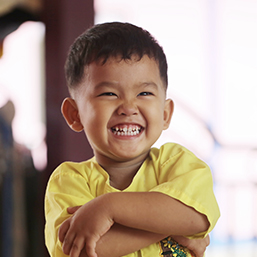
Toddlers are little people with big feelings. Sometimes, the only way for those big feelings to come out is through their actions: hitting, kicking, biting, flopping, or screaming.
\nIt’s not because you’re a bad parent or that they’re a bad person. The feelings must get out and, as a toddler, there isn’t much of an ability to control how that happens.
\n \nTo give some background, as a parent of a toddler, you know that they are still working on getting bodily functions under control. Toilet training is about learning what needing to void feels like, how to control it, and where to let it out. This comes with teaching and practice.
\nJust like physical continence, emotional continence takes time to develop and learn. First, we have to know that a feeling is coming, then we have to know what to do with it, and then we need to practice, practice, practice.
\nBottom line, toddlers need our help to learn how to help themselves. Words are not enough. They need action.
\nIn the heat of the moment
\nIf they’ve hit before and you find yourself hoping that they won’t hit again, you’ll need another strategy. Until they learn and grow they will hit again, so plan for it and see if you can stop it from happening before it happens. This will help to break the habit.
\nYour toddler might need your help to control their hands (or feet). Be ready to use gentle, but firm, hands to hold their arms and stop the hitting.
\nFor example: “I can see you need some help to control your hands. Let’s keep everyone safe and control your hands.”
\nUse emotion words they don’t have yet so that they can get used to the language.
\nFor example: “You feel angry,” “You don’t like this,” or “You are having a big feeling.”
\nThey need to learn to let their arms relax and stop hitting.
\nFor example: “When your arms go soft, I will know that you have control of your body. Let’s breathe and let your arms go soft. I know you can do this! All kids work at learning this.”
\nWhen they do let their arms soften, let go and offer praise.
\nFor example: “I knew you could get control of your hands. Good for you!”
\nThis could happen quickly or could take some time. Keep yourself and all kids safe. They will learn.
\nOnce everyone has calmed down
\nWhen things are calmer, there are many ways to help your toddler learn about big feelings.
\nRead books about feelings. I love the books by Cornelia Spelman: When I Feel Sad, When I Feel Angry, When I Feel Jealous.
\nIn any children’s storybook, notice the way the character looks when a feeling comes on. Does their face get red? Do they scrunch their fists and tummy? Ask your child what they feel like when they get mad or sad. Where do they feel it in their body? Share where you feel it.
\nNotice how the character lets out their anger.
\nTeach songs and actions about getting big feelings out. Practice these when things are going well as part of the games you play, so that you can use them when big feelings come. There are lots of great examples on YouTube.
\nNormalize feelings
\nFor many of us when we were growing up, it was not okay to feel feelings. Maybe you were told, “Stop crying, or I’ll give you something to cry about!”
\nIt is hard for a parent to watch our kids feeling sad, angry, or jealous. The fact is, we all feel feelings and the only way to get through them is to feel them and let them out in a way that keeps everyone safe. Our kids need to know that we can handle their big feelings. We can stay calm while our kids feel the feeling. When we model that calm response, our child can get there faster. This is not the same as ignoring the feeling. We need to name it, show that we get it, and help it to leave the body.
\nTry a phrase like this: “You are having a big feeling, that’s normal. It’s okay for you to not like what’s happening. I’ll help you through it. It will be over soon. We can do this together.”
\nKids change
\nThis behavior is quite normal for a toddler. When children behave in ways that we don’t like, it is usually an indication that they have something new to learn. Our job is to be watching for those moments and find ways to teach the new skills that fit their developmental level.
\n\n
Author, blogger, podcast host, and parenting expert, Julie Freedman Smith has been supporting parents across North America for 20 years. Through her company JFS Parent Education, she helps parents find relief from their everyday parenting challenges. Want to know how she can help you? Email her today:
\n
See our related articles:
\nCalgary’s Child Magazine © 2025 Calgary’s Child